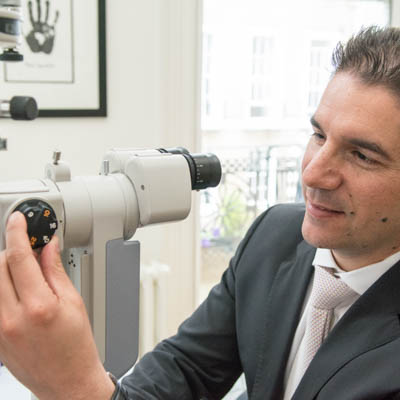When was LASIK invented?

Vision impairment problems affect a huge percentage of the world’s population. In fact, estimates show that around 2.2 billion people have a near or distance vision impairment. And this percentage isn’t just isolated to our times.
Throughout history, there have always been people who suffer from poor vision – and this isn’t surprising.
The human eye is the body’s second most intricate and complex organ – the first being the brain. With over 2.2 million moving parts, the human eye requires an incredibly precise arrangement of tissue and components in order to function correctly.
If even one of these components is faulty – whether that be misshapen, misaligned, or malfunctioning – our vision can be significantly affected. The way in which the light enters the eye can affect our ability to focus. Imperfections in the eye can be the cause of everything from a slight distortion to complete blindness.
Early methods of Vision Correction
For hundreds of years, people have turned to external devices to improve their view of the world. The earliest known invention of spectacles dates back a staggering 800 years ago!
These early eyeglasses, along with the many developed after, and the more recent addition of the contact lens, aimed to do what many people’s natural lenses can’t: alter the angle at which light enters the eye to create a more focused and accurate image.
While glasses and contact lenses have helped countless people, they do have their drawbacks and annoyances. I mean, what can you expect from a technology developed in the 13th century?
Luckily for us, we live in modern times. Times when we have the knowledge – and the technology to back it up – to do away with glasses and contact lenses altogether. We live in the time of Laser Eye Surgery.
Looking into the origins of LASIK Laser Eye Surgery
Doctors have been looking for ways to reshape the eye’s natural lens – the cornea – since the 1800s. However, this wasn’t done for real until the 1940s when Spanish ophthalmologist Jose Barraquer started experimenting with the correction of errors in corneal refraction — how our eyes bend light — that eye surgery finally began to take off.
His research led to the invention of the microkeratome, a precision surgical instrument still used today to create the corneal flap in LASIK. For his pioneering work, Barraquer is known today as the Father of Modern Refractive Surgery.
Over the next few decades, we saw several incremental advancements in the field of eye surgery. However, it wasn’t until the 1980s that we saw the next significant development: the excimer laser.
It was Stephen L. Trokel, an American Professor of Ophthalmology, together with a research group at IBM, who first uncovered the possibility of using the newly-invented excimer laser to perform surgical cuts within the cornea, but outside of the visual axis.
John Marshall, a British Professor, then adapted the laser to remove central corneal tissue, which became the origin of Laser Eye Surgery as we know it today. With this, the first widely used Laser Eye Surgery technique – named photorefractive keratectomy (PRK) – was born.
After this huge development, it took several more years to join the dots to introduce a procedure that combined the microkeratome and excimer laser. Independent groups, including Razhev and Lantukh in Russia, an Italian doctor by the name of Lucio Buratto, and Ioannis Pallikaris in Greece, all contributed to this advancement.
By 1989, the process no longer required the complete removal of a section of the cornea – like in PRK. Instead, surgeons could reshape the cornea with the just creation of a small flap. This was the beginning of safer, more effective Laser Eye Surgery, and the era of laser-assisted in situ keratomileusis, or (LASIK).
The future of Laser Eye Surgery?
LASIK is still the go-to technique for many Laser Eye surgeons around the world. However, technology and knowledge are continually advancing in this field. Take, for example, one of the latest developments in Laser Eye Surgery: Book a Consultation today. Alternatively, give us a call on 020 7224 1005.


